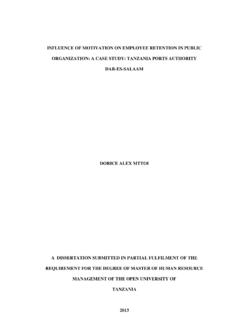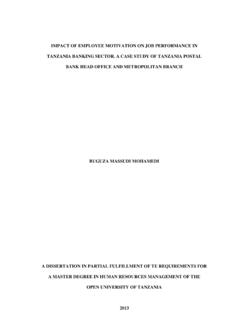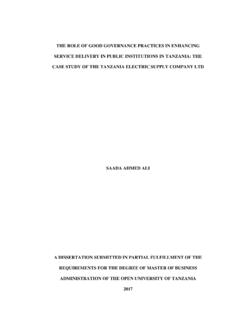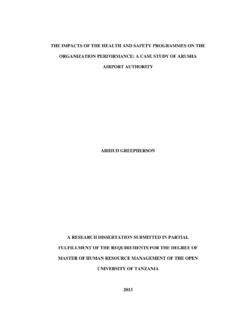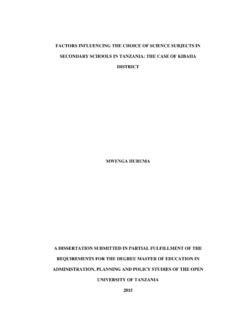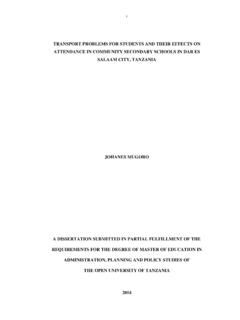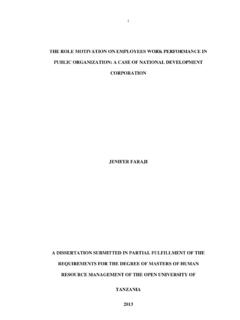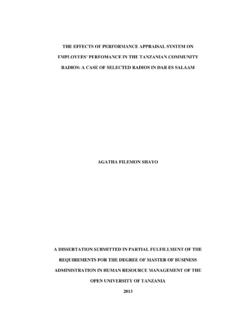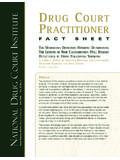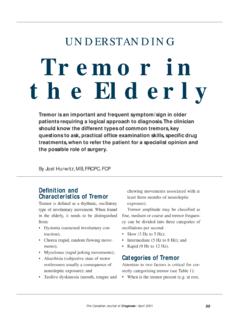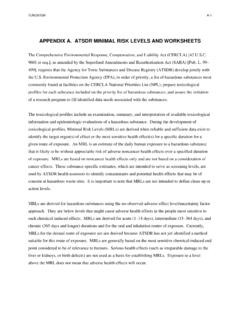Transcription of PERCEPTION AND UNDERSTANDING OF …
1 PERCEPTION AND UNDERSTANDING OF pregnant WOMEN TOWARDS THE USE OF FOLIC ACID SUPPLEMENT THE CASE study OF TEMEKE DISTRICT NEEMA GABRIEL MGONJA A DISSERTATION SUBMITTED IN PARTIAL FULFILLMENT FOR THE REQUIREMENTS FOR THE DEGREE OF MASTER OF SOCIAL WORK OF THE OPEN UNIVERSITY OF TANZANIA, 2014 ii CERTIFICATION The undersigned certify that he has read and hereby recommend for examination of thesis/dissertation entitled PERCEPTION and UNDERSTANDING of pregnant Women towards the use of Folic Acid Supplement the Case study of Temeke District, in partial fulfillment of the requirements for the degree of Master of Social Work of The Open University of Tanzania.. Dr. Huruma L. Sigalla (Supervisor) .. Date iii COPYRIGHT No part of this dissertation may be reproduced, stored in any retrieval system, or transmitted in any form by any means, electronic, mechanical, photocopying, recording or otherwise without prior written permission of the author or the Open University of Tanzania in that behalf.
2 Iv DECLARATION I, Neema G. Mgonja, declare that this dissertation is my own original work and that it has not been presented and will not be presented to any other University for a similar or any other degree award.. Signature .. Date v DEDICATION This dissertation is lovingly dedicated to my Mother and the late Father for their support and guidance vi ACKNOWLEDGEMENT This work has been made possible through the efforts and support of several individuals. However before all, I would like to thanks the Almighty God for giving me health and strength to accomplish this work. I would like to express my deepest gratitude to my supervisor Dr. Huruma L. Sigalla for his excellent guidance, caring, patience, encouragement, and UNDERSTANDING in developing study design, field work, analysis and successful completion of this study . Special thanks and appreciation is extended to my lecturers, and members of Open University of Dar es salaam for their assistance and guidance.
3 I wish to acknowledge the students of Masters of Social Work Programme for their support and advice throughout my study . I am equally profoundly grateful to my family especially my mother and brother for their material and moral support during the whole time of my study thank you for the incredible inspiration, support, commitment and affection you showed me. I am grateful to Chiallo, Mwajuma Mwihumbo, Juliana Lumbo Hospital Matron, management and all members of Temeke, Kigamboni and Mbagala Hospitals, involved in this study are likewise thanked for their cooperation and support in getting the information required for this study . vii ABSTRACT This study investigated the PERCEPTION and UNDERSTANDING of pregnant women towards the use of folic acid supplement. The study was conducted at Temeke District in Dar es Salaam region. Data were collected using Focused Group Discussion as well as In-depth interview.
4 The study reveals that most of women were aware of the FeFo supplement given to women before, during and after pregnancy. The finding also shows that most women are aware of the anemia as one of the dangerous diseases which can cause death of both a mother and unborn child. Findings suggest that the supplements available and accessible to all women are free of charge. Findings also reveal that health providers are all aware of dosage the pregnant women required before, during and after giving birth. Moreover finding signifies that there is still very low level of UNDERSTANDING among the women concern the use of these supplement especially on the positive and negative effect if they are taken or ignored respectively. The study reveals that some women drop or ignore using the medication deliberately simply because they have bad smell or make them uncomfortable. The findings on the side of health providers showed that of the pregnant women prescribed with supplement do not finish the dose; they assert that it brings nauseas and affect their digestive system.
5 The findings also signifies that regardless of the education provided to people especially pregnant women yet it s upon the UNDERSTANDING of women to determine their fate as you cannot force them. The study reveals that there are women deliberately decide not to take the supplement and therefore the problem remained unsolved. The study concludes that regardless of the education provided to people especially pregnant women, yet it s upon the UNDERSTANDING of women to determine their fate as you cannot force them. viii TABLE OF CONTENTS CERTIFICATION .. ii COPYRIGHT ..iii DECLARATION .. iv DEDICATION .. v ACKNOWLEDGEMENT .. vi ABSTRACT .. vii TABLE OF CONTENTS ..viii LIST OF TABLES .. xi LIST OF ABBREVIATION .. xii CHAPTER ONE .. 1 INTRODUCTION .. 1 Introduction .. 1 Background to the Research Problem .. 2 Anemia in pregnant Women .. 4 Tanzania Nutrition Policy and 5 The Economic Cost of Micronutrient Deficiencies in 6 Statement of the Problem.
6 8 Objective of the study .. 10 General Objective .. 10 Specific Objectives .. 10 Research Questions .. 11 Significance of the study .. 11 ix CHAPTER TWO .. 12 LITERATURE REVIEW .. 12 Introduction .. 12 The Use of Folic Acid and Anemia Problem in Tanzania .. 13 Effect of Anemia .. 16 Theoretical Framework .. 18 CHAPTER THREE .. 22 RESEARCH METHODOLOGY .. 22 study Area .. 22 Characteristics of the study 22 study Population .. 22 Research Design .. 23 Sampling Procedures .. 23 Method of Data Collection .. 24 Interview .. 24 The Process Used During the Interviews .. 24 Focus Group Discussion .. 25 Focus Group Discussion Guide .. 25 Data Analysis .. 26 Sample Size .. 26 Ethical Consideration .. 26 CHAPTER FOUR .. 27 study FINDINGS, ANALYSIS AND DISCUSSION .. 27 Introduction .. 27 x Demographic Characteristics of the Respondents .. 27 Age of the Respondents .. 27 Marital Status .. 28 Educational Level .. 28 PERCEPTION and UNDERSTANDING on Ferric Folic Acid.
7 29 Dosage .. 32 Accessibility of Folic Supplement in ANC .. 46 CHAPTER FIVE .. 48 DISCUSSION OF THE FINDINGS .. 48 Introduction .. 48 Usage of the Folic Supplements .. 48 Accessibility of Folic Supplements .. 50 CHAPTER SIX .. 52 SUMMARY, CONCLUSIONS AND RECOMMENDATIONS .. 52 Introduction .. 52 The Main Findings of the study .. 52 Conclusion .. 54 .. 55 REFERENCES .. 57 APPENDIX .. 61 xi LIST OF TABLES Table : Current Levels of Micronutrient Deficiencies in Tanzania Micronutrient Indicators Source .. 6 Table : The Human Cost of Micronutrient 7 Table Estimated Costs of Iron, Folic Acid and Vitamin A Deficiencies in 7 Table Age Group Distribution by Percentage .. 27 Table : Marital Status Distribution by Percentage .. 28 Table : Education Level Distribution by Percentage .. 28 xii LIST OF ABBREVIATION CDC Centers of Disease Control and Prevention ECSA-HC East, Central and Southern African Health Community FeFo Ferric Folic Acid HB Haemo Globin HIV Human Immune Deficiency Virus HMIS Health Management Information System IMR Infant Mortality Rate MDG Millennium Development Goals MDH Management Development for Health MSD Medical Store Department NGO Non-governmental organization NSGRP National Strategy for Growth and Reduction of Poverty NTD Neural Tube Defects PPH Post -Partum Hemorrhage SD Standard deviation TDHS The Tanzania Demographic Health Survey TFNC Tanzania Food and Nutrition Centre USA United State of America WHO World Health Organization CHAPTER ONE INTRODUCTION Introduction This chapter introduces the study by providing background information and statement of the problem.
8 Thereafter, it further highlights the objectives of the study , research questions and the significance of the study . Folate is a type of B vitamin. It is also called folic acid. Daily oral iron and folic acid supplementation is recommended as part of the antenatal care to reduce the risk of low birth weight, maternal anaemia and iron deficiency. The overall quality of the evidence for iron supplementation versus no iron was moderate for low birth weight, preterm birth, and maternal anaemia at term and maternal iron deficiency at term. The evidence was of low quality for birth weight, neonatal death, congenital anomalies, maternal death, maternal severe anaemia, and infections during pregnancy; whereas it was of very low quality for side-effects. Daily folic acid supplementation is recommended as part of the antenatal care to reduce the risk of low birth weight, maternal anaemia and iron deficiency (WHO, 2012) In Tanzania, 1999 data shows that only 44% of women were receiving iron supplements: In Eretria (1996-1997) only were receiving iron tablets and in Yemen only were receiving iron tablets.
9 Coverage is higher in Ghana (1998), Indonesia (1997), and Philippines (1998) where three-quarters of women are receiving iron during pregnancy, (TDHS, 2004-05). The connection between folic supplement and anemia is that if the body has enough folic acid this mean that it is hard to get anemia during pregnancy. 2 Anemia prevalence in pregnant women is one of the health problems confronting pregnant women. The prevalence of Anemia and severe anaemia in pregnant women were 60% and % in pregnant women respectively. pregnant women tend to become anemic because their blood is also used by the unborn child. The required blood of pregnant women is 11g/dl. However, during pregnant majority of the women are below 11g/dl thus during Ant natal (ANC) visit they are given folic acid supplement to help them increase the amount of blood which is real needed to their bodies and help them deliver safely (Massawe, 2002). Background to the Research Problem Anemia is a condition that occurs when the hemoglobin level in the blood is too low.
10 Hemoglobin is a protein in red blood cells which carries oxygen from the lungs to different parts of the body. When blood does not have enough haemoglobin, the body will not get the oxygen it needs. Human body needs iron in order to generate haemoglobin thus low iron in blood cause the most common kind of anemia (iron-deficiency anemia). It is important that before conceiving, a woman should take folic acid for production of red blood cells, as well as nor epinephrine and serotonin (chemical components of the nervous system). Folic acid also helps to synthesize genetic material in every cell of the body and normalize brain function. Taking folic acid before conception reduces the risk of neural-tube defects such as spina bifida (Urassa, 2002). Anemia in pregnancy is a serious public health problem worldwide. WHO (2001) estimates that, more than half of pregnant women in the World have a hemoglobin level indicative of anemia (< ), the prevalence may however be as high as 3 56% or 61% in developing countries.
